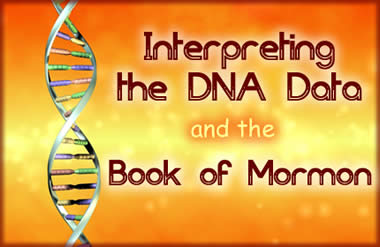 According to Latter-day Saints, the Book of Mormon was brought forth when God provided 22-year-old church founder Joseph Smith with special glasses and seer stones that enabled him to translate writings -- from "Reformed Egyptian" -- on golden tablets found in New York. Mormons believe these scriptures restored the church and left the rest of Christianity in apostasy.
The Book of Mormon has a compelling narrative about a tribe of Jews who sailed from Jerusalem to the Americas before the time of Christ and split into two factions. The Nephites were the good guys. In 1981, the word for them was officially changed from "white" to "pure." The Lamanites received the "curse of blackness." The Los Angeles Times provides the background:
According to Latter-day Saints, the Book of Mormon was brought forth when God provided 22-year-old church founder Joseph Smith with special glasses and seer stones that enabled him to translate writings -- from "Reformed Egyptian" -- on golden tablets found in New York. Mormons believe these scriptures restored the church and left the rest of Christianity in apostasy.
The Book of Mormon has a compelling narrative about a tribe of Jews who sailed from Jerusalem to the Americas before the time of Christ and split into two factions. The Nephites were the good guys. In 1981, the word for them was officially changed from "white" to "pure." The Lamanites received the "curse of blackness." The Los Angeles Times provides the background:
According to the Book of Mormon, by 385 AD the dark-skinned Lamanites had wiped out other Hebrews. The Mormon church called the victors "the principal ancestors of the American Indians." If the Lamanites returned to the church, their skin could once again become white.
This is not just a 19th-century teaching. Current Mormon president Gordon Hinckley has told Native Americans they are descended from one of the factions. The Times ran a story yesterday on DNA evidence that puts the story about the lost tribe of Israel in question.
From the time he was a child in Peru, the Mormon Church instilled in Jose A. Loayza the conviction that he and millions of other Native Americans were descended from a lost tribe of Israel that reached the New World more than 2,000 years ago.
"We were taught all the blessings of that Hebrew lineage belonged to us and that we were special people," said Loayza, now a Salt Lake City attorney. "It not only made me feel special, but it gave me a sense of transcendental identity, an identity with God."
A few years ago, Loayza said, his faith was shaken and his identity stripped away by DNA evidence showing that the ancestors of American natives came from Asia, not the Middle East.
"I've gone through stages," he said. "Absolutely denial. Utter amazement and surprise. Anger and bitterness."
My wonderful future in-laws are Mormon, and I have Mormon ancestors myself, so I'm always fascinated by tales of the Latter-day Saints. And this story is no exception. But it also provides fodder for thinking about how to treat the meeting of faith and science.
The headline of this piece is "Bedrock of a Faith is Jolted." But as Slate's William Saletan quickly summarizes (with a bit of attitude), the Latter-day Saints have worked around the problem with ease:
DNA evidence is rattling Mormonism. The church converted millions of Latin Americans and Polynesians with its scriptural story that they came from a lost tribe of Israel. DNA says they came from Asia instead. Old Mormon argument: The scripture is literally true. New arguments: 1) DNA evidence is being twisted by enemies of the church. 2) Maybe the folks who came from the lost tribe were few, and their DNA was "swamped" by immigrants from Asia. Try falsifying that! 3) "The Book of Mormon will never be proved or disproved by science." 4) We're "willing to live in ambiguity."
This DNA kerfuffle has been going on for years, long enough that I was wondering why the Times was covering it yesterday. The Latter-day Saints even put up a site for media specifically dealing with DNA and the Book of Mormon. I got the image above from a Mormon magazine article about the issue. One of the Mormon critics quoted in the Times piece published a book last year about the topic.
 Anyway, Mormonism is a large and growing religion and the DNA evidence problem isn't the only issue being dealt with from its scriptures:
Anyway, Mormonism is a large and growing religion and the DNA evidence problem isn't the only issue being dealt with from its scriptures:
For instance, the Mormon scriptures contain references to a seven-day week, domesticated horses, cows and sheep, silk, chariots and steel. None had been introduced in the Americas at the time of Christ.
But these issues have been discussed by Mormons for a very long time. Go to the Foundation for Ancient Research and Mormon Studies, a Mormon apologetic group, today and you can get the answer to this (declarative) question of the week:
The mention of windows that could be "dashed in pieces" in Ether 2:23 seems to be anachronistic, since glass windows were not invented until the late Middle Ages.
I really do think this is a fascinating story, but the notion that this is jolting the bedrock of the Mormon faith might be overstating it. I couldn't find any recent coverage in Utah papers, for instance. However, Peggy Fletcher Stack, the Salt Lake Tribune's religion reporter, likely covered it years ago. It would have also been helpful if reporter William Lobdell interviewed outside critics of Mormonism instead of just Mormons and ex-Mormons (and Mormon scholar Jan Shipps). It would also be great to see a follow-up that explores specifically how the DNA story relates to Mormonism's concern with geneology and lineage. Let us know if you see any coverage.
